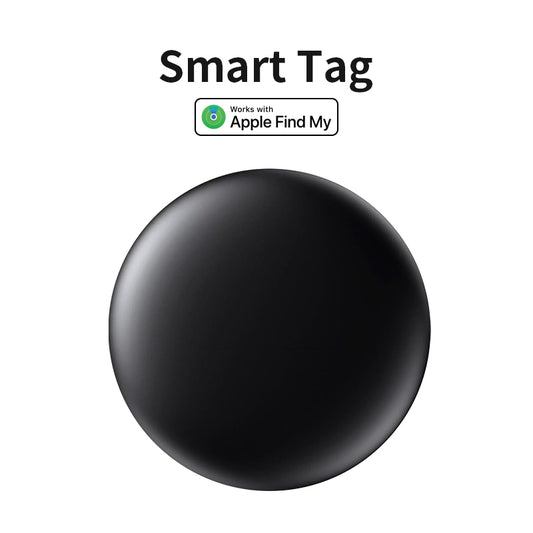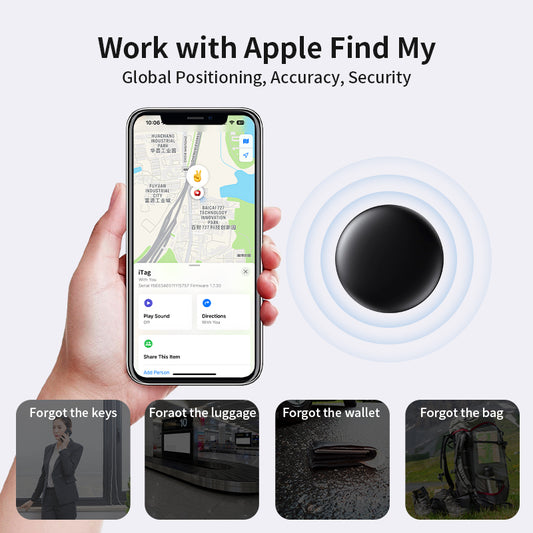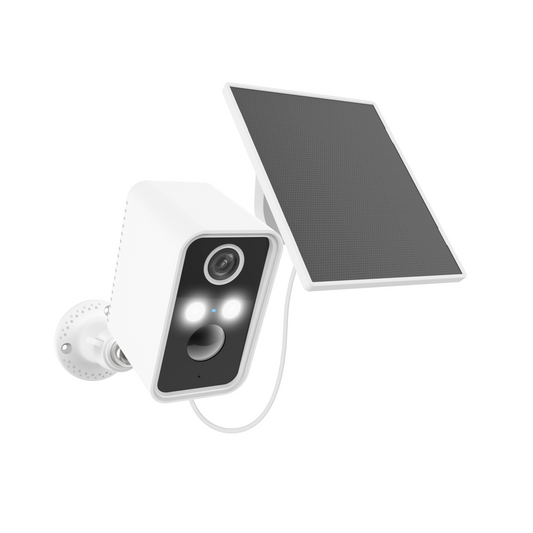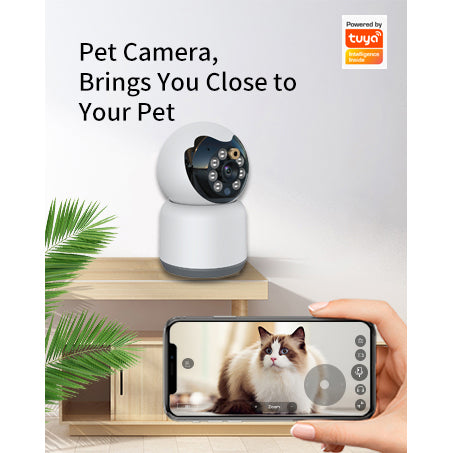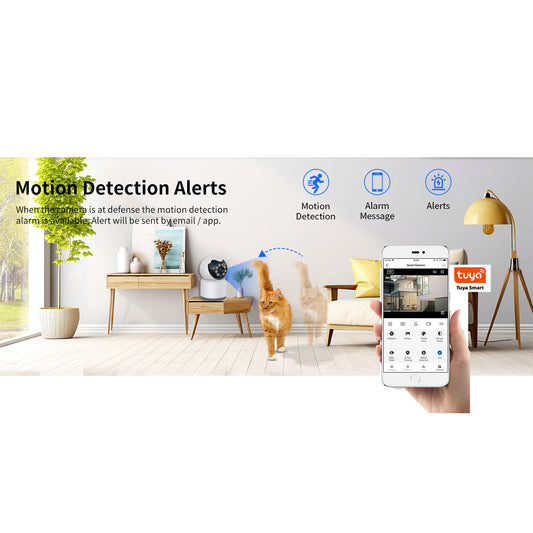
Pet Anxiety at Home: How Smart Cameras Help Comfort Pets.
Separation anxiety is more than a quirk—it's a panic response. Many pets bark, whine, or howl when left alone. They might scratch doors, chew furniture, or try to escape. Some even overgroom or soil the house, despite being trained.
After the pandemic, more families adopted pets. Now, owners want ways to reduce pet anxiety. They want to calm their pets without guessing what happens when they leave.

A smart pet camera is a game changer. They spot pacing or door-waiting and capture moments of whining or destructive behavior.
These tools help comfort pets remotely by revealing patterns you can act on. You get proof, not just hunches. This is vital for training plans that aim to reduce pet anxiety.
Used well, pet comfort technology can soothe anxious pets remotely. You can talk to pets remotely for quick reassurance or deliver a treat. But cameras are not instant cures.
Overusing two-way audio can feed dependence. The goal is steady independence. This is guided by evidence from your camera and simple changes at home that help calm anxious pets day by day.
Start with clarity, not guesswork. With the right smart pet camera and a consistent plan, you can comfort pets remotely. You can build confidence for the long term—one calm, recorded moment at a time.
Understanding Pet Anxiety at Home and Separation Anxiety in Dogs and Cats
Life at home should be safe, but many pets get anxious when routines change. To understand separation anxiety in dogs and cats, look for patterns. Use gentle structure to reduce barking and stress and prevent destructive behavior. Watching your pets closely and using home monitoring for pets helps you know what to do next.
Dog and cat stress signs to watch for when home alone
Stress signs in pets include constant barking or meowing, scratching, chewing, and accidents in the house. Some pets pace, won't eat, or try to get out. Others might groom too much or chew on their paws.
These signs often get worse when you're away. Paying attention to when and how often they happen helps you prevent destructive behavior and reduce barking and stress.
Distinguishing true separation anxiety from boredom or mischief
True pet separation anxiety starts when you get ready to leave. You might see clingy behavior, whining, and pacing before you go. After you leave, these behaviors keep going and follow a pattern tied to your absence.
Boredom, on the other hand, seems random and gets better with fun activities. Watching your pets with a camera can show how they react before and after you leave. This helps you train them to prevent destructive behavior.
Why rescue pets and routine changes can increase anxious behaviors
Rescue pets might have anxiety from past experiences or not enough socialization. Genetics and loud or crowded places can also make them more anxious. Changes like going back to work or moving can make things worse.
Neighbors might hear noise or see pets scratching at doors before you do. Home monitoring for pets can show if they're pacing, restless, or skipping meals. This helps you take steps to reduce barking and stress. If your pet starts acting differently suddenly, a vet visit can check for health problems that might be causing dog and cat stress signs.
How Smart Pet Cameras Provide Insights, Not Instant Cures
Smart tools show what stress looks like in real time. This is the core of smart pet camera benefits. They turn random worry into clear actions, helping pets feel calm when alone.
Think data, not drama. Short clips and timelines show moments of peace and stress. Use this data to shape routines, not to hover.
Using home monitoring for pets to identify triggers and patterns
Look for pacing near doors, window watching, and the start of vocalization. Note rest vs. true sleep, and any repeat spots for scratching or chewing.
- Track door-waiting and pacing streaks alongside deliveries or hallway noise.
- Flag the first bark or meow of a session to pinpoint timing.
- Review clips to see if a nap follows a trigger, or if restlessness keeps building.
When two-way audio camera features help vs. when they hinder independence
A two-way audio camera can soothe pets in a spike. A brief, calm cue may slow a spiral and help pets feel calm when alone. Used sparingly, it steadies the moment.
Overuse can backfire. Frequent talking risks tying relief to your voice, not the environment. Keep messages short, neutral, and rare, and pair them with gradual independence work so reassurance does not become the only off switch.
Leveraging motion detection pet alerts and barking/meowing detection
Motion detection pet alerts turn long days into tidy snapshots. With barking detection and meowing detection, you see when noise starts, how long it lasts, and what preceded it. This timeline is the practical side of smart pet camera benefits.
Some apps spotlight pacing bursts and repeated vocal runs, linking alerts to outside triggers. Use those insights to adjust timing, manage views, and set up quiet zones that support calm pets when home alone.
Soothe anxious pets remotely, Smart pet camera, Talk to pets remotely
Setting up a thoughtful space can help calm pets when you're away. Use an interactive pet camera to watch and then act. Small, steady actions can help pets feel more confident over time.
Plan the moment, not the minute. To soothe anxious pets, use brief contact and simple rewards. Let a routine help, with technology supporting your efforts.
Real-time voice talk to pets and the risk of reinforcing dependence
Real-time voice can calm pets with a neutral cue like “All good.” Keep it short and calm. Too much talking can make pets cling more and struggle when silent.
Use two-way audio only when needed. Avoid frequent check-ins. This helps pets learn to settle on their own.
Interactive pet camera benefits: treat tossers, puzzles, and engagement
Interactive pet cameras are great for rewarding calm behavior. Pair it with enrichment left at home.
- Offer a frozen, long-lasting food toy stuffed with kibble and dog-safe peanut butter.
- Set a slow-release puzzle to keep focus away from doors and windows.
- Use a brief toss to reinforce lying on a mat or resting in a crate.
These tools help pets relax when alone by redirecting their energy. Used wisely, they support training without hiding stress.
Best practices to calm pets when home alone without over-reassurance
Keep pre-departure calm. Slip out while your pet is busy with a chew or puzzle. Use real-time voice for true distress, not routine checks.
- Stage the room: safe zone, water, and a durable chew ready to go.
- Start the enrichment, then leave quietly without fanfare.
- When needed, deliver one neutral voice cue or a single treat toss.
- On return, keep greetings soft and brief to maintain steady energy.
This approach calms pets when alone and comforts them remotely. Over time, talk to pets less, and let the camera be timely support, not a crutch.
Behavior Modification That Reduces Pet Separation Anxiety
Small steps lead to big changes. Behavior modification can help pets feel more confident and calm. It's all about positive changes, not punishment. Keep training sessions short and fun to make progress every day.
Desensitizing departure cues and building duration gradually
Pets pick up on patterns. To help, make leaving cues not scary. For example, pick up keys, then stay home. Do this at random times to break the link.
Then, start with small steps of time apart. Begin with seconds in the same room. Reward calm behavior. Gradually increase time and distance. If stress comes back, slow down and try again. This method builds confidence and reduces anxiety.
Reducing attention-seeking to prevent destructive pet behavior
Attention-seeking behaviors like jumping or whining can be stopped. Ignore these behaviors until calm. It might take time for your pet to adjust.
Make leaving quiet for 30 minutes before you go. Give a stuffed toy before leaving. When you return, wait for your pet to calm down before greeting. This helps avoid destructive behavior linked to your comings and goings.
Positive reinforcement and when to seek professional guidance
Positive reinforcement is key. Reward calm behavior like relaxed posture or quiet time on a mat. This approach teaches pets good behavior without fear.
If you hit a roadblock, talk to a vet or a certified animal behaviorist. They can adjust plans and help manage anxiety. They're experts at reading pet stress signals and making changes for the better.
Creating a Calming Environment to Reduce Barking and Stress
Home can feel like a sanctuary when it's predictable and cozy. Create safe zones with familiar bedding and toys in a quiet room or well-fitted crates.
Keep routines steady. Feed, walk, and wind down at consistent times. Open blinds for natural light when it helps. Set out soft resting spots to invite naps instead of pacing.
Safe zones, crates, pheromone diffusers, and soothing music
- Make the den inviting: a covered crate or nook with a chew-safe mat, a worn T-shirt, and a favorite toy.
- Use pheromone diffusers near resting areas to calm anxious pets and reduce barking and stress during departures.
- Play low-volume classical or ambient tracks; many households find BBC radio or Spotify’s “Peaceful Piano” steady the room.
Introduce crates with short, happy sessions and high-value rewards. If your dog is sensitive, ask a certified trainer for guidance so the crate remains a positive retreat.
Exercise and enrichment to prevent destructive behavior
Channel energy before you leave. A brisk walk, a game of fetch, or scent work lowers arousal and helps prevent destructive behavior.
- Rotate puzzle feeders, treat dispensers, and durable chews.
- Hide small rewards around the safe zone so alone time links to good outcomes.
- Offer short training bursts—sit, place, settle—to reinforce calm and build confidence.
Mentally tired pets rest more easily, which helps calm anxious pets across the day.
Night vision pet monitoring to verify rest vs. pacing at night
Use night vision pet monitoring to spot patterns after lights out. If you see pacing, adjust the evening: a later walk, white noise, or moving the safe zone away from street noise may help reduce barking and stress.
Review clips to confirm what works—new bedding, a different diffuser location, or a softer playlist—so changes stay targeted and kind.
Choosing the Right Smart Pet Camera and Accessories
Start by setting clear goals for your pet camera. Do you need to watch your pet indoors, outside, or while you're away? Think about the quality of the video, how easy the app is to use, and reliable motion alerts. Also, consider privacy and your budget.
Two-way audio camera, laser pet teaser camera, and treat dispensers
A two-way audio camera is useful if you use it calmly. Look for clear speakers and mics. Laser pet teaser cameras can be fun but keep sessions short to avoid overstimulation.
Treat dispenser cameras reward pets for being quiet. Use timed or manual rewards to teach them to stay calm during noise. Keep sessions short and end on a positive note.
Find my pet tracking camera and solar-powered outdoor pet camera options
For pets that wander or escape, a find my pet tracking camera or tracker is helpful. It adds location awareness beyond the home. It's great for confirming routes and finding pets quickly.
Solar-powered outdoor pet cameras keep an eye on your yard without needing to charge often. They can record delivery activity or wildlife, helping you plan training.
Local vs. cloud storage, privacy, and reliable motion alerts
Decide between local and cloud storage based on your needs. Local storage keeps data on the camera and is quick to review. Cloud storage extends your archives and offers off-site backups, but often requires a subscription.
Focus on reliable motion alerts that detect animals, barks, or meows. This helps cut down on false alerts. Make sure the app supports activity zones, is easy to set up, and allows for quick sharing.
Real-World Camera Features That Help Calm Anxious Pets
Small, thoughtful tools can make a big difference. Quiet structure beats constant check-ins. Use night vision pet monitoring with planned routines. This keeps feedback clear and kind.
Interactive pet camera benefits: redirecting energy and rewarding calm
Interactive pet cameras are great for redirecting energy. Use them to give treats or puzzles before you leave. This can help break anxiety and reward calm behavior.
Set automated bursts on a schedule. Use your voice sparingly to avoid dependence.
Motion detection pet alerts for pacing, excessive vocalization, door-waiting
Motion detection pet alerts can spot stress spikes right away.
Use targeted clips to confirm pacing or scratching. Set door-waiting alerts near exits. Night vision pet monitoring shows if your pet is resting or roaming at night.
Scheduling quiet times and zoning to reduce triggers
Scheduling quiet times helps you stay on track. Mute non-urgent pings during training windows. Review highlights later to see progress.
Define zoning around doors and windows. This highlights problem spots without constant buzz. Focused zones reduce false alarms and make alerts more useful.
- Set pre-departure enrichment to start calm behaviors.
- Review motion detection pet alerts to match triggers with fixes.
- Lean on zoning and scheduling quiet times to keep coaching consistent.
Why Not Deal: Pet Comfort Technology That Makes Home Life Calmer
At Why Not Deal, we aim to make pets feel safe and owners informed. We use real behavior science in our designs. Our smart pet camera shows what triggers anxiety, while training and a calm setup build confidence.
Our devices are made for everyday use. They send motion alerts for pacing or watching doors in real time. You can soothe pets with clear two-way audio without making them dependent. Treat dispensers reward quiet moments, and night vision checks if pets are sleeping or roaming.
We also offer tools for outdoor care. A find my pet tracking camera helps find escape artists quickly. A solar-powered outdoor camera keeps an eye on things without extra wiring. These tools, along with enrichment and safe zones, help pets settle when you leave.
When technology is humble and purposeful, homes become calmer. Use a smart pet camera to observe and pair it with training. Choose features that fit your routine. With Why Not Deal, you can soothe anxious pets, reduce barking and stress, and calm them when you're away.
FAQ
What is separation anxiety in pets, and how does it show up at home?
Separation anxiety is when pets get really upset when left alone. They might bark a lot, chew on furniture, or scratch doors. A pet camera can help you see these signs and tell if it's just mischief.
What stress signs should I watch for when my dog or cat is home alone?
Look for signs like pacing near exits or waiting by doors. They might also drool, soil the house, or chew on things. Night vision cameras can show if they're restless at night, helping you make changes.
How do I tell true separation anxiety from boredom or mischief?
True anxiety starts before you leave and gets worse when you're gone. It's different from boredom, which happens even when you're home. A pet camera can show you these differences.
Why are rescue pets and routine changes linked to anxious behaviors?
Rescue pets might have had tough pasts, making them more anxious. Changes like moving or going back to work can also stress them out. About 14% of dogs have separation anxiety, and many pets were adopted during the pandemic.
How do smart pet cameras help if they’re not instant cures?
Cameras help you understand your pet's behavior. They show you what triggers their anxiety. This information helps you make better plans to help them feel better.
How should I use two-way audio so it helps and doesn’t harm independence?
Use two-way audio only when your pet is really upset. Avoid talking to them too much, as it can make them rely on you too much. The goal is for them to feel calm and independent.
What’s the value of motion detection pet alerts and barking/meowing detection?
Alerts help you know when your pet is stressed. They show you when they're upset, like by outside noises. This helps you make changes to help them feel better.
Can I soothe anxious pets remotely without creating dependence?
Yes, you can calm them down without making them too dependent. Use voice commands sparingly and give them things to do on their own. This helps them feel calm without needing you all the time.
What are the interactive pet camera benefits for anxious dogs and cats?
Interactive cameras can distract them from being anxious. They can play games or get treats, which helps them relax. Just make sure not to overdo it, so they don't get overwhelmed.
What are best practices to calm pets when home alone?
Make leaving the house calm and quiet. Give them a toy filled with treats before you go. When you get home, wait until they calm down before greeting them. Keep routines the same and use toys to keep them occupied.
How do I desensitize departure cues and build duration?
Start by doing things that make them think you're leaving without actually leaving. Reward them for staying calm. Gradually increase the time and distance you're away, but don't push too hard if they get anxious.
How can I reduce attention-seeking and prevent destructive behavior?
Ignore them when they're being attention-seeking. They might get upset at first, but they'll learn. Reward them when they're calm and relaxed, which encourages good behavior.
When should I seek professional guidance, and from whom?
If your pet's anxiety doesn't get better, talk to your vet to rule out health issues. Then, work with a positive trainer or behaviorist. Changing behavior takes time, and it's okay if you have setbacks.
How do I create a calming environment that reduces barking and stress?
Create a safe space with familiar things like bedding and toys. Use pheromone diffusers and calming music. Keep routines consistent for feeding, walks, and playtime. For sensitive pets, choose a quiet room.
What exercise and enrichment help prevent destructive behavior?
Give them lots of exercise and mental challenges before you leave. Use puzzle toys and durable chews. Frozen food toys can keep them occupied for a long time.
How does night vision pet monitoring guide better routines?
Night vision shows if your pet is sleeping or pacing. If they're restless, adjust their evening routine or add calming sounds. This helps reduce stress at night.
What features matter most in a smart pet camera vs. a wireless home pet camera?
Look for cameras with reliable alerts, clear audio, and night vision. Activity zones and scheduling help avoid false alarms. These features give you useful insights to help your pet.
Should I choose a two-way audio camera, laser pet teaser camera, or treat dispenser?
Choose based on your pet's needs. Two-way audio is good for calming them down. Treat dispensers reward calm behavior. Laser toys can be fun, but use them carefully to avoid frustration.
What about a find my pet tracking camera and a solar-powered outdoor pet camera?
Tracking cameras help you find your pet if they get lost. Solar-powered cameras let you watch your yard without needing to charge them often. They're great for catching triggers like delivery people.
How do local vs. cloud storage, privacy, and alerts impact daily use?
Local storage is quick and easy to review, but cloud storage lets you access footage from anywhere. Choose cameras with strong privacy and alerts that work well for pets.
How do interactive features help redirect energy and reward calm?
Interactive features like remote treat tossing and puzzles can calm your pet. They help them focus on something else and reward them for being calm.
How do motion detection pet alerts help with pacing and vocalization?
Alerts show when your pet is stressed, like by outside noises. This helps you make changes to help them feel better.
How do scheduling and zoning reduce triggers and over-alerting?
Scheduling and zoning help you focus on important areas. This reduces false alarms and helps your pet feel safer and more calm.
How does Why Not Deal support calmer, safer homes?
We create smart pet cameras and other tools to help pets feel better. Our cameras offer features like two-way audio and alerts to help reduce anxiety and destructive behavior. We aim to make homes safer and calmer for pets and their owners.





